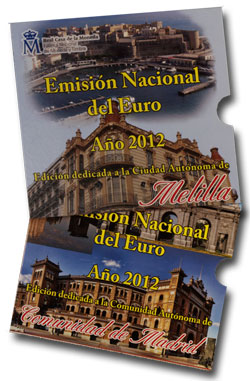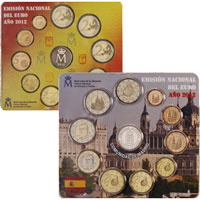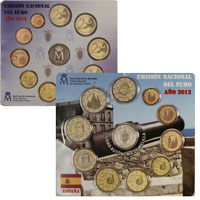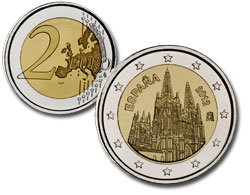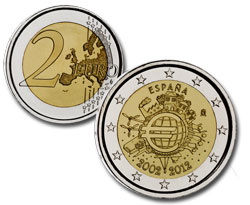Euro 2012 Coinage -Autonomous Regions
Introduction
Continuing with the releases in the special series dedicated to each of Spain's Autonomous Communities, the Spanish Royal Mint is putting on sale two collector coins, one pertaining to Madrid and the other to Melilla. The differentiating element on each coin is the inclusion of a medal that reproduces the coat-of-arms of the respective Autonomous Community or City.
This year the set comes with two commemorative coins, each of a 2-euro face value, one dedicated to Burgos Cathedral and the other, European in scope, in honor of the Tenth Anniversary of the Euro.
The release includes the Spanish euro coin set for 2012. This is presented as a limited edition in a practical numbered coin case that protects the coins while at the same time allowing both coin sides to be viewed in their entirety.
Details
In this edition the coin cases with uncirculated euro coins include a medal in sterling silver portraying the coat-of-arms of either Madrid or Melilla.
The maximum mint run of this Euro set with coins minted in 2012 is 20,000 units of each coin.
| Name | Face value | Weight | Diameter |
|---|---|---|---|
| 1 Cent | 0,01 € | 2,30 g | 16,25 mm |
| 2 Cent | 0,02 € | 3,06 g | 18,75 mm |
| 5 Cent | 0,05 € | 3,92 g | 21,25 mm |
| 10 Cent | 0,1 € | 4,10 g | 19,75 mm |
| 20 Cent | 0,2 € | 5,74 g | 22,25 mm |
| 50 Cent | 0,5 € | 7,80 g | 24,25 mm |
| 1 Euro | 1 € | 7,50 g | 23,25 mm |
| 2 Euro | 2 € | 8,50 g | 25,75 mm |
| 2 Euro commemorative | 2 € | 8,50 g | 25,75 mm |
| 2 Euro commemorative | 2 € | 8,50 g | 25,75 mm |
| Madrid Medal | -- | 6,72 g | 24,00 mm |
| Melilla Medal | -- | 6,72 g | 24,00 mm |
1 Eurocent
The façade of the Santiago de Compostela Cathedral is depicted on the obverse. The reverse is common to all the Euro Zone countries.
2 Eurocent
The façade of the Santiago Compostela Cathedral is depicted on the obverse. The reverse is common to all the Euro Zone countries.
5 Eurocent
The façade of the Santiago de Compostela Cathedral de Santiago is depicted on the obverse. The reverse is common to all the Euro Zone countries.
10 Eurocent
The bust of Miguel de Cervantes Saavedra is reproduced on the obverse. The reverse is common to all the Euro Zone countries.
20 Eurocent
The bust of Miguel de Cervantes Saavedra is reproduced on the obverse. The reverse is common to all the Euro Zone countries.
50 Eurocent
The bust of Miguel de Cervantes Saavedra is reproduced on the obverse. The reverse is common to all the Euro Zone countries.
1 Euro
The effigy of H.M. the Spanish King is depicted on the obverse. The reverse is common to all the Euro Zone countries.
2 Euros
The effigy of H. M. the Spanish King is depicted on the obverse. The reverse is common to all the Euro Zone countries.
2-Euros commemorative coin - Burgos Cathedral
The sixth issue of the 2-Euro commemorative coin released in 2012 was dedicated to the Cathedral of Burgos, one of the loveliest examples of Gothic art. The cathedral was qualified as a Heritage of Mankind monument in 1984.
The coin obverse will depict a rendering of Burgos Cathedral. Folloiwing the 2011 issue, this will be the third coin in the annual series dedicated to sites in Spain listed on the UNESCO World Heritage Register.
2-Euros commemorative coin - 10th Anniversary of the Euro
Citizens and residents of the Euro zone selected the award-winning design for the new Euro coin that will commemorate the tenth anniversary of banknotes and coins in the Euro currency. About 35,000 people took part in online voting to choose one of the five designs that had been pre-selected by a professional jury from among those submitted in a contest open to the public of the entire Euro zone.
Helmut Andexlinger's award-winning design symbolizes the way in which the Euro currency has transitioned over the last ten years to acquire undeniable weight worldwide and the importance it has on the life of the man in the street (represented by the people shown in the design), on trade (the ship), industry (the factory) and energy (the wind farms).
The Madrid Silver Medal
This sterling silver medal is a tribute to Madrid, a single-province autonomous community with Madrid as its capital.
In the 16th century king Philip II set the capital of his monarchy in the town of Madrid, and it has been so ever since, with a brief interval of time between 1601 and 1605 when Philip III transferred the capital to Valladolid. Also since that time the country's government has had its headquarters in Madrid, except during the Civil War when it was relocated first to Valencia and later to Barcelona.
With the Constitution of 1978 and the "Statute of Autonomy", the province of Madrid was officially established as a single-province autonomous community by reason of its economy and demographics and for being the province that accommodated Spain's capital.
The Community of Madrid is home to three Heritage of Mankind sites: San Lorenzo de El Escorial, the University of Alcalá de Henares and the historical complex, and the Cultural Landscape of Aranjuez.
The obverse depicts the coat-of-arms pertaining to the Madrid autonomous community.
The reverse portrays the crowned letter "M", the mintmark of the Spanish Royal Mint.
The Melilla Silver Medal
This sterling silver medal is dedicated to Melilla, one of Spain's north African autonomous cities, located on the south-eastern coastline of the Cap de Trois Fourches headland, by the shores of the Mediterranean Sea and across from the southern coast of the Iberian Peninsula.
In ancient times Melilla was a Phoenician trading settlement known as Rusaddir and a strategic port in the wars between Carthaginians and Romans. The Romans granted the enclave the status of a colony and included it in the Iberian territory.
During the expansion of the Moors into Spain Abderrahman III incorporated Melilla into the Caliphate of Córdoba at the end of the 9th c. In the 13th c. it passed to the Marinids in Fes. The battles between Fes and Tlemcen (in Algeria) wrought havoc on Melilla. On September 17, 1497, it was occupied by Spanish troops. From the 16th to the 19th centuries Melilla was the site of battles with its neighboring territories and an important center for cultural and commercial interchange. In 1859 the Moroccan king recognized the sovereignty of Melilla over its adjoining territory.
The obverse shows the coat-of-arms of the Melilla autonomous community.
The reverse portrays the crowned letter "M", the mintmark of the Spanish Royal Mint.
The order in which the series will be issued is shown in the following table:
- 1. ANDALUSÍA
- 2. ARAGÓN
- 3. CANARY ISLANDS
- 4. CANTABRIA
- 5. CASTILLA AND LEÓN
- 6. CASTILLA-LA MANCHA
- 7. CATALONIA
- 8. AUTONOMOUS CITY OF CEUTA
- 9. AUTONOMOUS CITY OF MELILLA
- 10. COMMUNITY OF MADRID
- 11. CHARTER COMM. OF NAVARRE
- 12. VALENCIAN COMMUNITY
- 13. EXTREMADURA
- 14. GALICIA
- 15. BALEARIC ISLANDS
- 16. LA RIOJA
- 17. BASQUE COUNTRY
- 18. PRINCIPALITY OF ASTURIAS
- 19. REGIÓN OF MURCIA
Prices
Official retail price in Spain, excluding any relevant taxes:
Blister
Madrid - 27,27 Euros
Autonomous City of Melilla - 27,27 Euros

